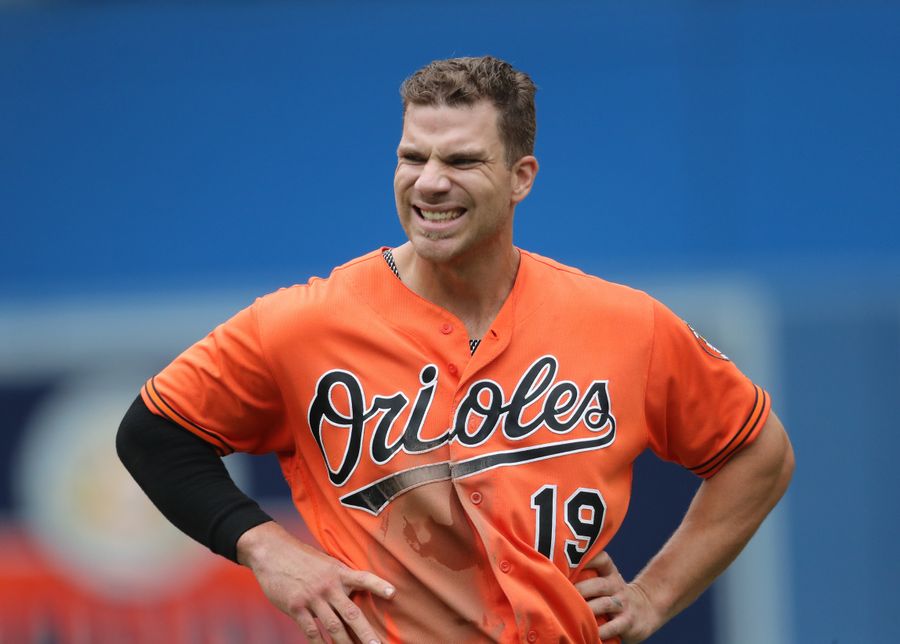The Baltimore Orioles Have Been Even Worse Than They Look
 When you consider it in its totality. credits: Tom Szczerbowski | source: Getty Images
When you consider it in its totality. credits: Tom Szczerbowski | source: Getty Images In 2005, the Baltimore Orioles shocked the world with a 42-28 start, good enough to keep them in first place in the AL East into mid-summer. This was before Rafael Palmeiro, fresh off his 3000th hit, lied to Congress and tested positive for steroids; before ostensible ace Sidney Ponson was arrested for drunk driving for the second time in a calendar year; and well before the manager, Lee Mazzilli, was fired unceremoniously in August. The team eventually staggered to a 74-88 finish, fourth place, 21 games behind Boston and New York. It was a season miserable enough to warrant its own tribute Twitter feed 10 years later.
In 2007, things were even worse: 69-93 by the merciful end, and 27 games out of the division lead. On August 22, the Orioles faced the equally awful Texas Rangers and were tagged for 30 runs. Relievers Brian Burres and Rob Bell allowed 13 hits, four walks, and 15 earned runs in the course of getting six outs. It was the most lopsided loss of the modern era.
In 2008, it was last place. In 2009, last place and 98 losses. In 2010 ... you get the idea. The pall of woe lasted in to 2011, when on August 24, with the Birds once again in the cellar and digging furiously, beloved team executive and broadcaster Mike Flanagan was found dead by suicide at his home. Local media reported that Flanagan—a Cy Young winner in 1979, member of the 1983 championship team, and an inductee to the Orioles Hall of Fame—was “despondent over what he considered a false perception from a community he loved of his role in the team’s prolonged failure.” That 2011 season was the last of 15 straight losing seasons for the O’s, a stretch that covered a period in my life from pre-puberty past the birth of my second child.
Mathematically, 2018 was the worst Baltimore baseball season in history, and day to day it somehow felt even worse than that.
All this to say: Baltimore fans have known crappy teams. We’ve known sorrow at the end of a promising season and despair during the middle of a hopeless one. Heartbreak and helplessness are our natural states. For 15 endless years, the Orioles were the kings of laughable trades and withering former greats. The team was terrible once again in 2018, but this one felt different. This season felt panicky, flop-sweaty from the get-go. This organization has seen its share of Hindenburgian immolations, but this craft didn’t even get off the ground. The crew started fighting and quitting, then the engine caught fire before anyone even charted a course. Mathematically, 2018 was the worst Baltimore baseball season in history, and day to day it somehow felt even worse than that.
Once again, the grim reality was more than clear by August, but something about that month really underscored the point. There was a stretch from the 10th to the 26th when the Orioles were swept in four by Boston, lost a three-game series to Cleveland, then swept in four by the Yankees. Somewhere in that fever dream, they lost 15-6 to a forlorn and godforsaken Mets team at the very bottom of its own deepest trough.
It wasn’t bad baseball, or even tragic baseball. It was baseball as a train derailment, a sprint off a cliff, an infinite Wile E. Coyote loop in which the Roadrunner is somehow the team’s own haplessness. In 2018, the Orioles blew past the previous franchise single-season loss record with almost two weeks to go. Even then, the brand was strong: loss 108 came after the bullpen surrendered four unearned runs to lose a lead in the seventh. The earlier record was set in 1988, when the team infamously started off 0-21. That campaign was cursed enough to inspire a children’s book by Cal Ripken, Jr., but there aren’t any lessons about gumption to be learned from 2018. Kids shouldn’t even be told about this season.
At the franchise’s previous nadir, there was always some pretense towards competition. The front office seemed to never accept the concept of full-on rebuilding, but fans also constantly griped about Peter Angelos’s penny-pinching and meddling. They were unwilling or unable to commit to any legible course of action, which is why their sudden success in 2012, the team’s first winning season of my adult life, felt so miraculous.
Now, after this year of losing, there are no such illusions. A mid-season fire sale scattered what was once the team’s core: Manny Machado, Jonathan Schoop, Zach Britton, Darren O’Day, and Kevin Gausman were sent to more competitive teams, netting a grand total of one top-50 prospect. Only Adam Jones and Chris Davis were left from the short-lived glory days. Jones, the greatest Oriole since Cal, may be gone before Thanksgiving; if there was any justice, Baltimore would throw him a goodbye parade and offer his family free Berger cookies and Attman’s corned beef for life.
That’ll leave the profoundly and almost poignantly untradeable Davis, who has four years remaining on a preposterous seven-year, $161 million contract dating back to his brief rein as MLB dinger king. In 2018, he was literally the worst hitter ever, striking out in nearly half of his at-bats. “Failure just follows me around daily,” he told Sports Illustrated’s Stephanie Apstein, in a piece that both unsparingly depicts his awfulness and movingly conveys his torment. You don’t have to care about the Orioles to wish for better things for the guy, but he’ll be in Baltimore no matter what comes. Through 2022, he’ll be the unofficial mascot of a squad that now looks less like a recent division winner and more like a corpse cart being dragged through a medieval town square.
By WAR, the most valuable player currently on Baltimore’s roster is Richard Bleier, a 31-year-old reliever who has been on the DL since June.
But Davis should only shoulder so much blame. The entire team underperformed, Machado included, as if there was some festering rot in the guts of Camden Yards. (That would at least explain the vermin.) Take as one example Andrew Cashner, the pride of the team’s offseason free agent acquisitions. A 32-year-old starting pitcher who might be a decent third guy in a good rotation, Cashner was supposed to anchor Baltimore’s, and the club signed him to a two-year, $16 million deal in February. To his credit, Cashner was in dire need of run support all year and has lost time to DL stints, but that doesn’t fully explain his career-worst 5.29 ERA or awful strikeout and walk rates, although those do at least help explain his 4–15 record. Cashner wasn’t Baltimore’s worst starting pitcher this year—David Hess’s 5.85 was worse by FIP, and Chris Tillman was so much worse by every metric that the team cut him loose after seven starts—but the trying to assess who was the best is a bleak task. Dylan Bundy is the most electric, but he has also allowed 39 homers in 30 starts. Alex Cobb has been the steadiest but hasn’t really been what anyone would consider good. By WAR, the most valuable player currently on the roster is Richard Bleier, a 31-year-old reliever who has been on the DL since June and will finish the year having thrown 32-and-two-thirds innings. As of this moment, with four games left to go, the Orioles are 60.5 games back in the division.
Take a deep breath, things get worse. In September, Ken Rosenthal detailed the various off-the-field obstacles that Baltimore will have to navigate as these lost years play out. Manager Buck Showalter and GM Dan Duquette’s contracts are up, and Showalter is not expected back. The team’s neverending TV-rights squabble with the Nationals will soon come to a potentially transformative close in arbitration hearings, at which point the club will have to negotiate a new lease on Oriole Park at Camden Yards right as attendance falls into a chasm. Before any of this comes to pass, MLB will demand to know who, exactly, is running the team now that Peter Angelos’ long-failing health prevents him from even appearing in public.
What does total free-fall look like for the workaday fan? For the last ten years or so, I’ve been part of an ongoing email thread between a group of Baltimore-connected friends. The Orioles are the ostensible reason for the chain, the only thing we all really have in common anymore, though it’s unavoidably become a record of new jobs, cross-country moves, advanced degrees earned, marriages, births, illnesses, and the wider muck and awe of adult life. We’ve now spanned the Orioles’ interlude of competence, from the final-game spoiler victory of 2011 to the surprise resurgence of 2012 and the magical run to the 2014 ALCS. This year, two people on the list became dads, another got divorced, and one lost a beloved dog, but the thread remained mostly quiet. The slow-motion catastrophe in progress back on Eutaw Street was, quite literally, chilling.
I would like to underline this again: the 2018 Orioles were so bad that I fell out of touch with friends. Their futility, relentless day-to-day drumbeat of it and the depth of it, only added to the greater sense of hopelessness I have about the world. It felt less like being trapped under an unwelcoming weather pattern than like climate change. This season failed to uplift in any way; it lacked catharsis or tragedy or disbelief. It was just a broad ritual of repulsion unlike anything I’ve ever seen. Once Jones leaves, we’ll have nothing to root for but minor-league acquisitions and whatever ignominious record-breaking may come. In 1962, when the Mets lost 120 games, they at least they had the excuse of being a brand-new expansion team, and the world at least got a Jimmy Breslin book out of it. Will the storied, once-fearsome Orioles vaporize that monument to awfulness, too? There’s always next year.
John Lingan is the author of “ Homeplace: A Southern Town, a Country Legend, and the Last Days of a Mountaintop Honky-Tonk.” He’s on Twitter at @johnlingan.

